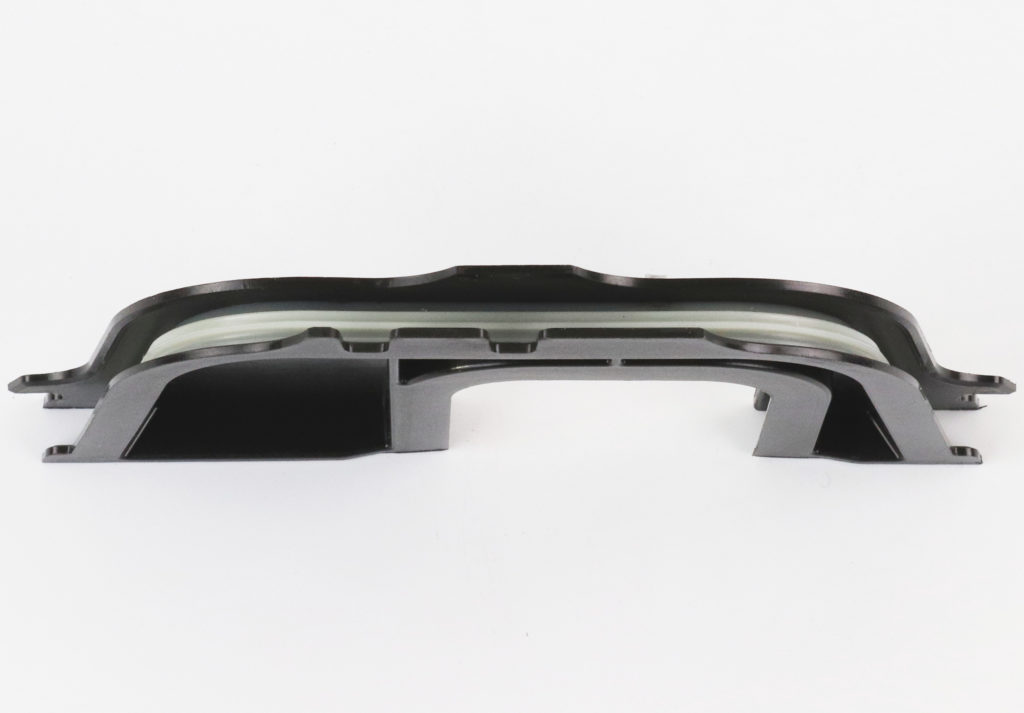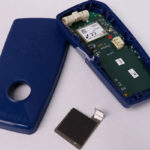
Bi-injection molding, or 2k injection molding, is a plastic injection process allowing the production of a part made of two materials with different characteristics using a single press and a single tool. Examples of its use include parts requiring two colors or two different hardness levels. As a specialist in plastic injection molding, we’ve developed advanced know-how in dual injection molding of plastic materials.
This solution can be advantageous (in time and cost terms) while also satisfying very precise constraints. Bi-material injection molding involves a certain technicality and requires good mastery of tool design, materials selection and the injection phase itself. For this reason, we can support you upstream of your project to guarantee that it remains feasible and viable.
Our injection workshop is equipped with automated presses and is suitable for this type of process (up to 480 tones). Molds used for bi-injection are also manufactured in our in-house mechanical workshop.
WHAT ARE THE APPLICATIONS FOR YOUR BI-INJECTION PARTS?
Applications of bi-injection molding are quite numerous in a variety of industries such as household, cosmetic and electrical products and increasingly in the automotive sector.
We regularly produce all types of bi-material parts according to our customers’ needs. Below are 3 examples of parts we have produced, illustrating the 3 primary applications of bi-material thermoplastic injection:

AESTHETICS
A very common application of the bi-injection process is to produce parts made of two similar materials but with different masstinted colours – in this case, creamy white with red.
Bi-material part for the food sector.
Materials : PP and PP

FUNCTIONALITY
Another application of bi-injection is injecting a material with another material to create a soft or grip effect in a functional gripping area (flexible or rigid material) – tactile grip effect on matte red.
Bi-material part for the industrial sector.
Materials : ABS and SEBS

SEALING
A third application of bi-material injection is to develop sealing functions with molding of joints directly on the part without the need for an assembly step after injection.
Bi-material part for the automotive sector.
Materials : PA and SEBS
Other applications are also possible, depending on the type of part and the specifications of your product. Bi-injection molding also allows the production of transparent parts comprising an opaque zone (colored or not) to create colorful graphics and elegant finishes that enhance product functionality and added value. It’s possible to create rigid zones with flexible zones: hinge effect, shock-absorbing zones, push buttons, etc.
Bi-injection molding of compatible materials
In general, all thermoplastic polymers, from the simplest to the most technical, are compatible with the bi-injection process. In the case of flexible materials, the over-molded material is generally SEBS/TPE (Styrene-ethylene-butylene-styrene) or TPU (thermoplastic polyurethane) with different Shore hardnesses and possible textures. Most often, the two assembled components are different but similar and show good chemical compatibility.
What are the pros and cons of bi-injection molding?
Whether or not to use bi-material injection depends on various inherent constraints of your project and a preliminary study to validate your selection is generally required. Bi-injection is often used for large-volume production, complex geometries or in cases where over-molding is not suitable. Below we present some of the advantages and disadvantages of this process compared to mono-injection or over-molding:
ADVANTAGES OF BI-INJECTION
– Reduced unit cost per part
– Elimination of assembly step
– Single production phase (reduced lead times)
– Complex geometries possible
– Improved integrity and durability
DISADVANTAGES OF BI-INJECTION
– High tonnage machine required
– Tooling more complex and expensive
– Longer cycle time
HOW DOES THE BI-INJECTION MOLDING PROCESS WORK?

In general, the process is fairly similar to conventional (single material) injection molding. The materials are brought to their melting point and then fill the mold cavities.
Bi-injection uses a press equipped with a second screw and hopper to inject the complementary material at the same time. The definition of the parting line is generally validated during the part analysis phase.
In single-material injection, resin is injected into a cavity and then, after an appropriate cooling time, the two mold halves are opened, and the part is ejected. In biomaterial molding, the two resins are injected into the mold. For this purpose, a space must be created in the mold to accommodate the additional resin. To do this, several bi-injection methods for tooling are available: transfer molds, molds with rotatory plate, molding with a rotating base, molding with core-back process.
Depending on the properties of the part and the project constraints, our team of designers and engineers is responsible for determining the most suitable solution for you from among these different tools.
BI-MATERIAL INJECTION IN FPM INJECTION
Before including a bi-injection solution in your specifications, please contact us to determine that it is feasible and cost-effective. Our internal organization allows us to support you in your analysis since we benefit from having a design office and mechanical workshop in house.
We generally work in several stages:
– Feasibility study
– Part analysis
– In-house tooling design and development
– Mold flow analysis
– Machining of tools
– Testing and validation
– Series production





Leave A Comment